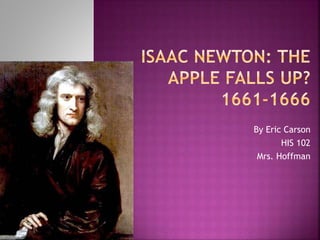Isaac newton: The Apple Falls Up?
- 1. By Eric Carson HIS 102 Mrs. Hoffman
- 2. ’é× An accomplished mathematician, physicist and one of the leaders of the Scientific Revolution ’é× Born January 4th, 1643 ’é× Died March 31st, 1727 ’é× Born in Woolsthrope, England ’é× Known for his studies of Gravity, Optics, and Calculus
- 3. ’é× At nineteen, with help from his uncle, Newton gained acceptance to the Trinity College of Cambridge ’é× While there he paid his tuition by waiting tables at a local pub and doing other odd jobs for the school ’é× During his period at Cambridge Newton studied Optics, and it was his work with Optics that eventually allowed him to be accepted into the Royal Society
- 4. ’é× As the Plague came to Cambridge the school was shut down for a short period of time ’é× It was during this time that Newton would soon develop his ideas of Gravity ’é× The story goes that Newton was sitting under an apple tree in the country, and as he sat there he noticed an apple fall from its branch ’é× And he had to ask ŌĆ£But why? Why does the apple not just fall up?ŌĆØ
- 5. ’é× After watching the apple fall Newton went straight to work on his theory ’é× Newton was able to use an equation he created to determine the actual force needed to hold the moon in place ’é× He would eventually develop his Three Laws of Motion from this
- 6. ’é× NewtonŌĆÖs first Law States that ’éĪ ŌĆ£An object at rest stays at rest unless acted upon by another forceŌĆØ ’é× He built this concept off GalileoŌĆÖs concept of Inertia ’é× This example can be seen in things such as planes taking off or throwing a baseball OMG!
- 7. ’é× NewtonŌĆÖs Second Law states that ’éĪ ŌĆ£That there is a relationship between an objects mass and itŌĆÖs force. This is calculated by the equation F=ma.ŌĆØ ’é× F=ma is broken down as ŌĆśFŌĆÖ is Force, ŌĆśmŌĆÖ is the mass of an object and ŌĆśaŌĆÖ is the acceleration the object is under ’é× In modern day this has allowed to be able to calculate different dynamics such as the force of car crashes and the destructive power of bombs
- 8. ’é× NewtonŌĆÖs last law states that ’éĪ ŌĆ£For every action there is an equal of opposite reaction.ŌĆØ ’é× This means that for everything that we do there is always some kind of reaction ’é× You can see this in things such as firing a gun and a space ship launching http://www.y outube.com/ watch?v=d8Y W1tGkXSg
- 9. ’é× Newton would eventually publish his works, but he would waited over twenty years before he actually did ’é× The reason behind this is because Newton was very sensitive to criticism, and due to the very religious atmosphere of the time he decided to wait ’é× And of course we all know the result, because for over 300 years Newton has been known as the Father of Gravity
- 11. ’é× Hatch, Robert. "Sir Isaac Newton (1642-1727)." luminarium.org. Annina Jokinen, 27 06 2000. Web. 12 Nov 2010. <http://www.luminarium.org/sevenlit/newton/n ewtonbio.htm>. ’é× "Isaac Newtons Life." Newton.ac.uk. Microsoft Encarta, 1998. Web. 12 Nov 2010. <http://www.newton.ac.uk/newtlife.html>. ’é× Lacey, Robert. Great Tales From English History. Great Britian: Lttle, Brown and Company, 2004. 235-239. Print. ’é× White , Michael. Isacc Newton: The Last Sorcerer. Great Britian: Helix Books, 199. Print.











